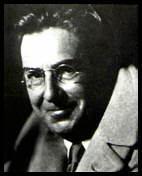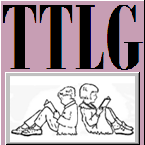The Authors and Illustrators - Profiles
Johnny Gruelle
Johnny Gruelle is best known for creating the world famous rag doll characters, Raggedy Ann and Andy. While the Raggedys were the indisputable centerpiece of Gruelle's career, in his heart of hearts, Johnny was a dyed-in-the-wool freelance artist, who felt most at home at his drawing board, crafting illustrations and features for newspapers and magazines.
John Barton Gruelle was born in Arcola, Illinois in 1880. At the age of two, his family moved to Indianapolis, where his father, R.B. Gruelle, became known as one of the Hoosier Group of Impressionist artists. By his early teens, John Gruelle already knew he was a cartoonist. During a train-hopping adventure to Cleveland, Ohio in 1894, his caricature of a beat cop named Tom McGinty so impressed the officer that he supposedly offered to stake Gruelle while the boy sought cartooning work at a local newspaper. As it turned out Gruelle did not stay on in Cleveland (although he would return to live there years later). But after this experience, a career spent painting landscapes and portraits like those his father rendered seemed far less appealing than one spent turning out pithy little funnies for a living.
In 1901 the 20-year-old Gruelle landed his first newspaper job, at an Indianapolis tabloid called the People. There he worked for several months creating rough-hewn "chalk-plate" portraits. By April 1902, Gruelle had moved on to the more mainstream Indianapolis Sun, while managing also to do work for the Detroit-based Peninsular Engraving Company.
In June 1903, Gruelle was hired at the brand-new Indianapolis Star as the paper's first assistant illustrator. His three years at the Star were interrupted by nine-months spent at the rival Indianapolis Sentinel. Once back at the Star, in 1905, Gruelle accepted a freelancing job with World Color Printing Company of St. Louis to produce four-color Sunday comics, a connection he continued after relocating to Cleveland in 1906 to work for the Cleveland Press and the Newspaper Enterprise Association. During these years, Gruelle would turn out as many as ten cartoons each week, his style steadily growing more expert and refined.
Although most of his early newspaper work was aimed at adults, by 1908, Gruelle had begun producing features for children. After winning a national comic drawing contest, Gruelle went to work for The New York Herald in early 1911. Although he would continue creating for adults, his most important audience became children, whom he kept entertained with colorful "Mr. Twee Deedle" Sunday comic pages. Once "Mr. Twee Deedle" was in print, it wasn't long before Gruelle was receiving commissions from a broad array of monthly and weekly magazines. His distinctive cartoons, illustrations, and illustrated stories appeared regularly in well-known publications including John Martin's Book, Physical Culture, Illustrated Sunday Magazine, McCall's, The Ladies' World, and Judge.
It was his illustrating work that led him to create a distinctive, whimsical design for a doll named "Raggedy Ann," which he patented and trademarked in 1915. Gruelle was soon pitching book ideas, and ultimately, he connected with the P.F. Volland Company, a juvenile publisher in Chicago. In 1918 Volland published Gruelle's Raggedy Ann Stories and also introduced a matching character doll, and the rest is history. More Raggedy books and dolls followed, and Gruelle eventually became known as "The Raggedy Ann Man."
Johnny eventually entered the arena of juvenile book illustrating and writing and achieved fame as creator of Raggedy Ann and Andy. However, Gruelle's newspaper and magazine work remained vital outlets for him, providing him not only with welcome income, but also a forum in which to explore an extensive range of illustrating and writing interests, in full view of hundreds of thousands of readers of all ages and persuasions.
In 1922, Gruelle's serialized "Adventures of Raggedy Ann and Andy" stories premiered in newspapers across the country. He continued providing artwork to adult magazines such as Life, Cosmopolitan, and College Humor, and kept up with his illustrated juvenile features, which appeared in Woman's World and Good Housekeeping. In 1929, Gruelle's full-color Sunday comic "Brutus" began what would be a nine-year run, and by 1934, his illustrated "Raggedy Ann" newspaper proverbs were in national syndication.
By the time of his death in 1938, Gruelle's Raggedy characters, dolls, and books were known throughout the world. However, his fanciful newspaper and magazine works had also kept Americans amused for nearly four decades, and Gruelle had become extremely well-regarded in cartooning and illustrating circles. Throughout his life, and in his heart of hearts, Johnny Gruelle was ever and always -- an artist.


An Online Children’s Book Review Journal
Through The Looking Glass Children’s Book Reviews
Online book reviews for the child in your life featuring both new and popular children's book authors

Kids book reviews, including book reviews of chapter books, novels, picture books, and non-fiction from famous children’s literature authors. Your review site of books for children.
Welcome to Through the Looking Glass Book Reviews. We have moved! Please visit the new site at www.lookingglassreview.com to enjoy the new website.


